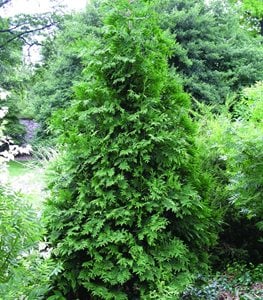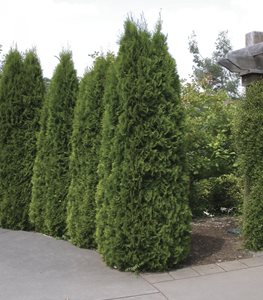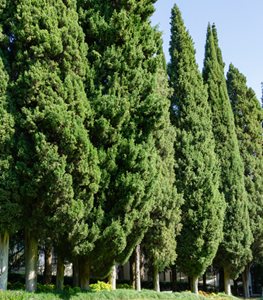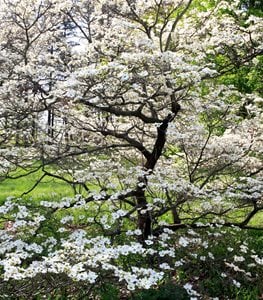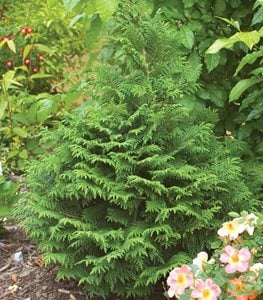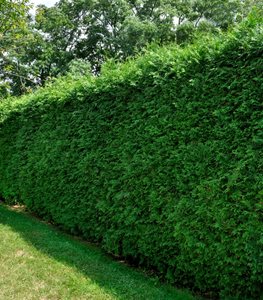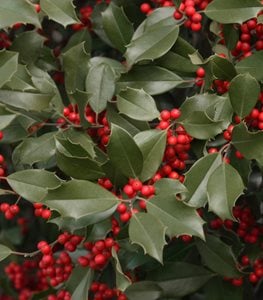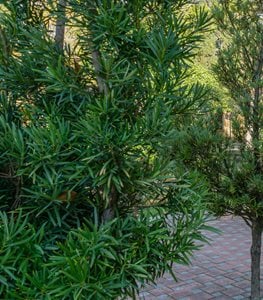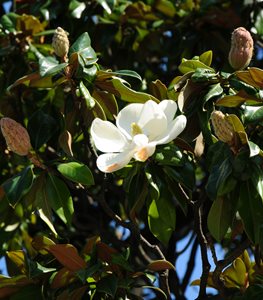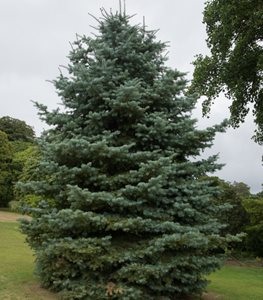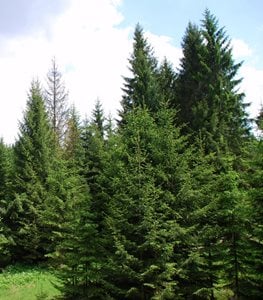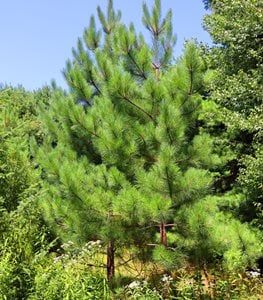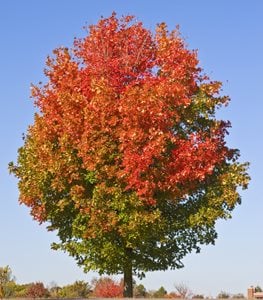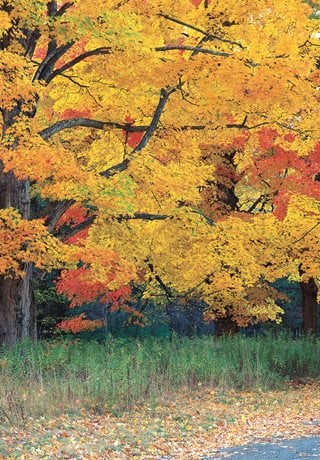15 Best Trees for Privacy in Your Garden
Add some of these great trees to your landscape for screening and privacyWhether you have a small urban yard, suburban lot, or spacious rural property, establishing privacy offers both protection and seclusion. Trees are a quick solution for blocking unsightly views or preventing neighbors from looking into your yard.
When choosing trees, consider:
- Hardiness
- Ease of maintenance
- Growth rate
- Amount of maintenance required
- How much space is needed for trees to mature
- Columnar or dwarf trees are more suited to smaller urban lots
- Bigger specimens can make a stunning statement on a larger parcel
Here are some of the most popular trees for privacy, including both evergreen and deciduous types.
Learn more: Privacy Landscaping: How to Design for Privacy
TREES FOR PRIVACY
GREEN GIANT ARBORVITAE (Thuja 'Green Giant')
Zones: 5-8
Exposure: Full sun to partial shade
Growth habit: Upright pyramidal habit
Height/Spread: 40 to 60 feet tall, 12 to 20 feet wide
Growth rate: Fast, 3 to 5 feet annually
This evergreen conifer is tolerant of various soil, water and light conditions, making it a low-maintenance solution for larger yards. Finely textured foliage maintains its glossy green coloring year-round. With a dense habit and rapid growth rate, this reliable tree provides a quick living screen. ‘Green Giant’ is a good disease-free substitute for Leyland cypress, particularly in the southeastern U.S.
Learn more about growing arborvitae.
EMERALD GREEN ARBORVITAE (Thuja occidentalis 'Smaragd')
Zones: 2-7
Exposure: Full sun to partial shade
Growth habit: Upright pyramidal habit
Height/Spread: 10 to 15 feet tall, 3 to 4 feet wide
Growth rate: Slow, 1 foot or less per year
Similar to ‘Green Giant’ but smaller, making it a good alternative for small urban yards. This evergreen conifer stays narrow and compact, needing little pruning or other maintenance. Flat sprays of glossy bright green foliage maintain their coloring in all seasons. Extreme cold tolerance makes this a good choice for northern climates.
ITALIAN CYPRESS (Cupressus sempervirens)
Zones: 7-11
Exposure: Full sun
Growth habit: Narrow columnar habit
Height/Spread: 40 to 70 feet tall, 3 to 20 feet wide
Growth rate: Medium, 1 to 2 feet per year
A popular choice for Mediterranean-style landscapes, this evergreen conifer is valued for its elegant narrow, tapered habit. The dark green foliage makes an attractive neutral backdrop for plants with colored foliage or flowers. Italian cypress is drought-tolerant, preferring dry climates and well-draining soil.
LEYLAND CYPRESS (x Cupressocyparis leylandii)
Zones: 6-10
Exposure: Full sun to partial shade
Growth habit: Upright pyramidal habit
Height/Spread: 60 to 70 feet tall, 15 to 20 feet wide
Growth rate: Fast, 2 to 3 feet per year
For a quick privacy solution, Leyland cypress is an evergreen conifer that can create a lush green screen in just a few growing seasons. This fast-growing tree can be allowed to reach its full size or kept pruned as a smaller specimen or hedge. Dense bright green sprays of soft needles are produced on upward curving branches, lending elegance to the landscape. May be disease-prone (highly susceptible to canker) in some areas, particularly the southeastern U.S., where Green Giant arborvitae is a good substitute.
DOGWOOD (Cornus spp.)
Zones: Tree forms are generally hardy in Zones 3-9, depending on the species
Exposure: Full sun to partial shade
Height/Spread: Tree forms can reach 10 to 40 feet tall and wide, depending on variety
Growth rate: Slow to moderate, 1 foot or less per year, depending on variety
These deciduous trees and shrubs offer something for every landscape. The most popular tree forms develop an attractive canopy that will screen out an unsightly view or add privacy to a front or back yard. The smaller stature of many varieties makes them suitable for smaller lots. Dogwoods have the added benefit of four-season interest, with attractive foliage, flowers, fruit, bark, and structure.
Learn more about growing dogwoods.
FALSE CYPRESS (Chamaecyparis spp.)
Zones: 4-9
Exposure: Full sun to partial shade; blooms best in full sun
Growth habit: Upright bushy or arching habit
Height/Spread: 1 to 20 feet tall, 3 to 10 feet wide
Growth rate: Fast; 1 to 2 feet per year
Though false cypress trees grow quite large in their native habitat, garden varieties are bred to be much smaller. This evergreen conifer has finely textured foliage and comes in varying shades of green, chartreuse, and purple. False cypress grows slowly, making a valuable addition to small urban spaces.
Learn more about growing false cypress trees and shrubs.
YEW (Taxus spp.)
Zones: 2-10, depending on variety
Exposure: Full sun to partial shade
Growth habit: Upright, mounding, arching, or columnar habit
Height/Spread: 4 to 60 feet tall, 4 to 20 feet wide, depending on the variety
Growth rate: Slow to medium, 8 to 16 inches per year
Yew is commonly used as formal hedging and topiary for its dense finely textured foliage that is amenable to regular shearing. This coniferous evergreen tree or shrub is especially long-lived, with some specimens living hundreds of years. Yew comes in many different sizes and shapes, and is tolerant of a wide range of growing conditions.
HOLLY (Ilex spp.)
Zones: 3-10, depending on the variety
Exposure: Full sun to partial shade; berries are produced best in full sun.
Growth habit: Upright, pyramidal, mounding, spreading, or weeping habit
Height/Spread: 1-1/2 to 80 feet tall, 1-1/2 to 50 feet wide
Growth rate: Slow to fast, from a few inches to more than 3 feet per year, depending on the variety
Holly is a diverse group of plants with deciduous or evergreen foliage that come in tree, shrub, or vine forms. American holly (Ilex opaca, pictured) is a broadleaf evergreen tree that is highly adaptable and makes a good screen for larger yards. Nellie Stevens holly (Ilex x ‘Nellie R. Stevens’) is a broadleaf evergreen tree with a pyramidal form that is suitable as hedging for smaller yards.
Learn more about growing holly.
PODOCARPUS (Podocarpus spp.)
Zones: 7-10
Exposure: Full sun to partial shade
Growth habit: Upright, columnar, or open habit
Height/Spread: 6 to 50 feet tall, 6 to 25 feet wide
Growth rate: Slow to medium; 6 to 24 inches per year
Podocarpus is grown for the attractive, finely textured foliage and dense growth habit that lends itself to shearing. Similar in appearance to yew, this evergreen tree is suitable for warmer regions and is adaptable to a wide range of light and soil conditions. Grow as a formal hedge, informal screening, or as a tree form.
SOUTHERN MAGNOLIA (Magnolia grandiflora)
Zones: 6-10
Exposure: Full sun to partial shade
Growth habit: Upright spreading habit
Height/Spread: 60 to 80 feet tall, 20 to 40 feet wide
Growth rate: Slow to medium; 1 to 2 feet per year
Southern magnolia is a stately tree grown for its fragrant white flowers, glossy dark green foliage and dense canopy. Commonly grown in warmer regions, this broadleaf evergreen can be used as a focal point in a larger landscape to block an unsightly view, or to edge a property line. ‘Little Gem’ is a dwarf variety suitable for small spaces, reaching 15 to 20 feet tall and 7 to 10 feet wide at maturity.
Learn more about growing magnolia trees.
WHITE FIR (Abies concolor)
Zones: 3-7
Exposure: Full sun to partial shade
Growth habit: Pyramidal habit
Height/Spread: 40 to 70 feet tall, 20 to 30 feed wide
Growth rate: Slow to medium, 1 to 2 feet per year
Also known as concolor fir, this exceptionally hardy evergreen conifer is a favorite of Christmas tree growers. Valued for its aromatic blue-green needles, ornamental upright-growing cones, and symmetrical structure, white fir thrives in regions with long cold winters and cool summers.
NORWAY SPRUCE (Picea abies)
Zones: 2-7
Exposure: Full sun to partial shade
Growth habit: Pyramidal or weeping habit
Height/Spread: 40 to 60 feet tall, 25 to 30 feet wide; can reach 100 feet or more in its native habitat
Growth rate: Meduim to fast, 1 to 2 feet or more per year
One of the most popular Christmas trees, Norway spruce is also a valuable landscape tree. The graceful branches are covered with dark green needles, which beautifully contrast with attractive large brown cones. ‘Cupressina’ is a smaller variety with a columnar habit that is suitable for narrow spaces.
EASTERN WHITE PINE (Pinus strobus)
Zones: 3-8
Exposure: Full sun to partial shade
Growth habit: Pyramidal, then open habit
Height/Spread: 50 to 80 feet tall, 20 to 40 feet wide
Growth rate: Fast, 2 feet or more per year
Eastern white pine is a common eastern U.S. native notable for its long, soft blue-green needles, large brown cones and stately upward-facing branching. Young trees are pyramid-shaped, developing an open, somewhat irregular canopy as they mature. ‘Fastigiata’ is a columnar variety more suited to smaller spaces.
CHINESE JUNIPER (Juniperus chinensis)
Zones: 4-9
Exposure: Full sun
Growth habit: Pyramidal, columnar, spreading, or open habit
Height/Spread: 3 to 60 feet tall, 4 to 20 feet wide
Growth rate: Slow to medium, 4 to 12 inches or more per year, depending on the variety
Native to parts of Asia, Chinese juniper, which occurs in both tree and shrub forms, is grown for the short blue-gray needles, dark blue berries, and dense growth habit. This reliable conifer is highly durable and adaptable to a range of growing conditions. ‘Blue Point’ (pictured) is a smaller, slower-growing variety.
Learn more about growing juniper trees and shrubs.
RED MAPLE (Acer rubrum)
Zones: 3-9
Exposure: Full sun to partial shade
Growth habit: Upright habit with a spreading canopy
Height/Spread: 40 to 70 feet tall, 30 to 50 feet wide
Growth rate: Medium to fast, 1 to 2 feet annually
Native to the eastern U.S. and Canada, red maple is one of the most widespread trees in North America. This deciduous shade tree is grown for the attractive lobed leaves and brilliant fall foliage in colors of red, burgundy, or yellow. Red maple is hardy in most zones and highly adaptable to a wide range of soil, water and light conditions, making it suitable for nearly any landscape.
RELATED:
Evergreen Trees
Shrubs for Privacy
Evergreen Shrubs
Garden Room Ideas for Extending Living Space

